NGC 4449
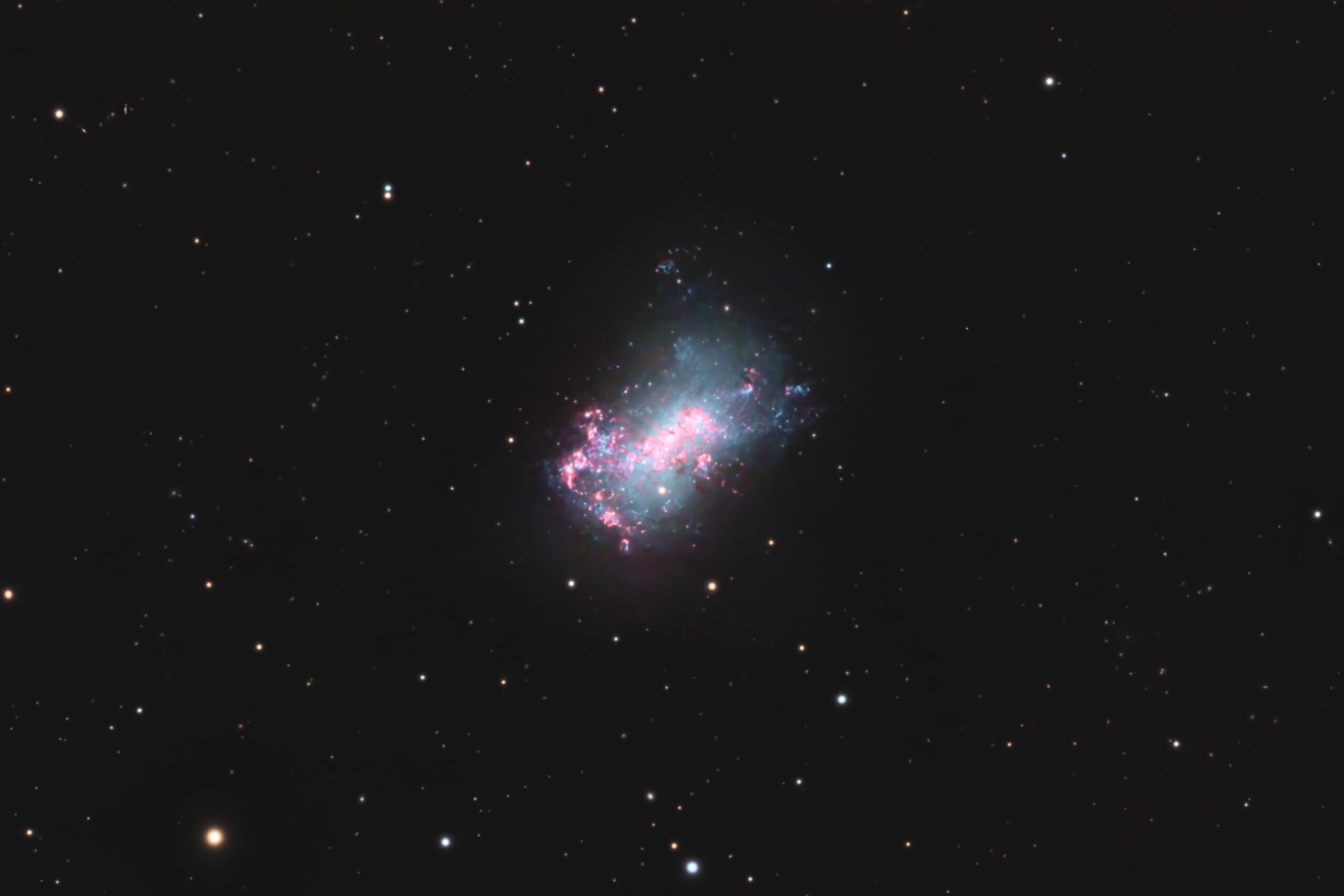 Click image for full size version
Click image for full size version
April 28, 2024
NGC 4449 is an irregular galaxy – meaning it is neither a spiral nor an elliptical galaxy. It’s located in the constellation of Canes Vanatici (the Hunting Dogs), and lies about 13 million light years away. It is thought to be similar in some ways to the Large Magellanic Cloud, one of the Milky Way’s satellite galaxies. Howevr, unlike our neighbour, NGC 4449 is very active in terms of star formation, and is considered a starburst galaxy. Several blue star clusters and pink nebulae are easily visible within it. The nebulae are star-forming regions similar to the Orion Nebula in the Milky Way.
Tekkies:
Acquisition, focusing, and control of Paramount MX mount with N.I.N.A., TheSkyX. Guiding with PHD2. Primalucelab low-profile 2″ Essato focuser and ARCO rotator. Equipment control with PrimaLuce Labs Eagle 4 Pro computer. All pre-processing and processing in PixInsight. Acquired from my SkyShed in Guelph. Data acquired under variable moonlight and average transparency and seeing between March 6-7, 2024.
Celestron 14″ EDGE HD telescope at f/11 (3,912 mm focal length) and QHY600M camera binned 2×2 with Optolong filters.
8 x 5m Red = 0hr 40m
9 x 5m Green = 0hr 45m
9 x 5m Blue = 0hr45m
26 x 5m Lum = 2hr10m
8 x 5m Ha = 0hr 40m
Total: 5hr 00m
Preprocessing: The WeightedBatchPreProcessing script was used to perform calibration, cosmetic correction, weighting, registration, local normalization, integration and Drizzle integration of all frames (Luminance only).
Gradient Removal: DBE was used to remove gradients from the all five masters.
RGB master: A master RGB image was made from the Red, Green and Blue masters using ChannelCombination in RGB mode.
Synthetic Luminance: A SynthL was made by integrating the five masters, weighted by SNR, with no pixel rejection
Colour Calibration: SpectroptometricColorCalibration was used to calibrate the RGB master.
Deconvolution: BlurXterminator was applied to the RGB, Ha and SynthL masters with Automatic psf , star sharpening set to 0.5, and non-stellar set to 0.5.
Star Removal: StarXterminator was used to remove the stars from the RGB, Ha and SynthL masters, with default settings, except Large Overlap was selected. The RGB and SynthL stars-only images were retained.
Linear Noise Reduction: NoiseXterminator was applied to the RGB, Ha and SynthL masters with settings Amount=0.9 and Detail=0.25
Ha Continuum Subtraction: The ContinuumSubtraction script was used to remove continuum emissions from the Ha image.
Stretching: HistogramTransformation was applied to the RGB, Ha and SynthL masters to make pleasing images. Approximate background level after stretch was 0.08 for Ha, 0.1 for SynthL and 0.09 for RGB.
Nonlinear Processing
Combinining SynthL and RGB: LRGBCombination was used to replace the lightness channel of the RGB image with the SynthL.
Saturation Boost: A mask was made using RangeSelection and used to select the galaxy, including the faintest regions. Curves was used to boost the saturation in the SynthLRGB master preparation for addition of Ha.
Addition of Ha to SynthLRGB: The NBRGBCombination script was used to combine the Ha with the SynthLRGB.
Nonlinear Noise Reduction: NoiseXterminator was used to reduce noise in the background areas of the SynthLHaRGB master with Amount=0.9 and Detail=0.15.
Re-stretch: HistogramTransformation was used to boost contrast by moving the dark point to the toe of the histogram and slightly decreasing the mid-point slider.
Contrast Enhancement: The CreateHDRImage script was used to compress the dynamic range of the core of the galaxy. Then LocalHistogramEqualization was applied twice using a mask to select the entire galaxy. A Contrast Limit of 1.5 and 1 iteration was used for each LHE application (scale 40, strength 0.2; scale 125, strength 0.15).
Sharpening: MultiscaleMedianTransform was applied. (Layers 1 – 6 with strengths of 0.01, 0.02, 0.02, 0, 0, and 0.02, respectively), using a mask to select only the brighter portions of the galaxy.
Contrast, Brightness and Colour: Background and galaxy brightness, contrast, and saturation were adjusted in several iterations using CurvesTransformation with masks as required.
Stars-only steps: HistogramTransformation was applied to the RGB and SynthL stars-only images. They were combined as for the starless images using LRGBCombination. The SynthL stars-only was used as a mask and CurvesTransformation saturation slider was used to boost colour in the stars.
Star Restoration: PixelMath expression combine(starless, stars, op_screen()) was used to combine the starless SynthLHaRGB starless image with the stars-only image.
Final Steps: Background, galaxy, and star brightness, contrast, hue, and saturation were adjusted in several iterations using CurvesTransformation with masks as required. ICCProfileTransformation (sRGB IEC61966-2.1; Relative Colorimetric with black point compensation) was applied prior to saving as a jpg. The finder chart was made using the FindingChart process.


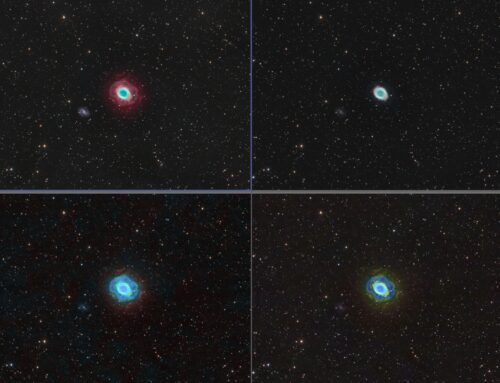

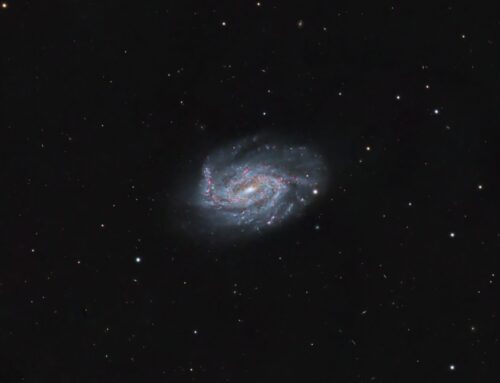
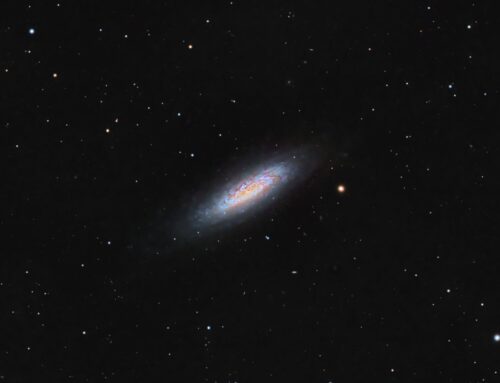
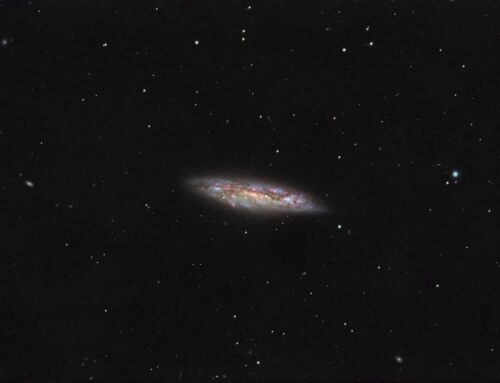
Very nicely done, great target.